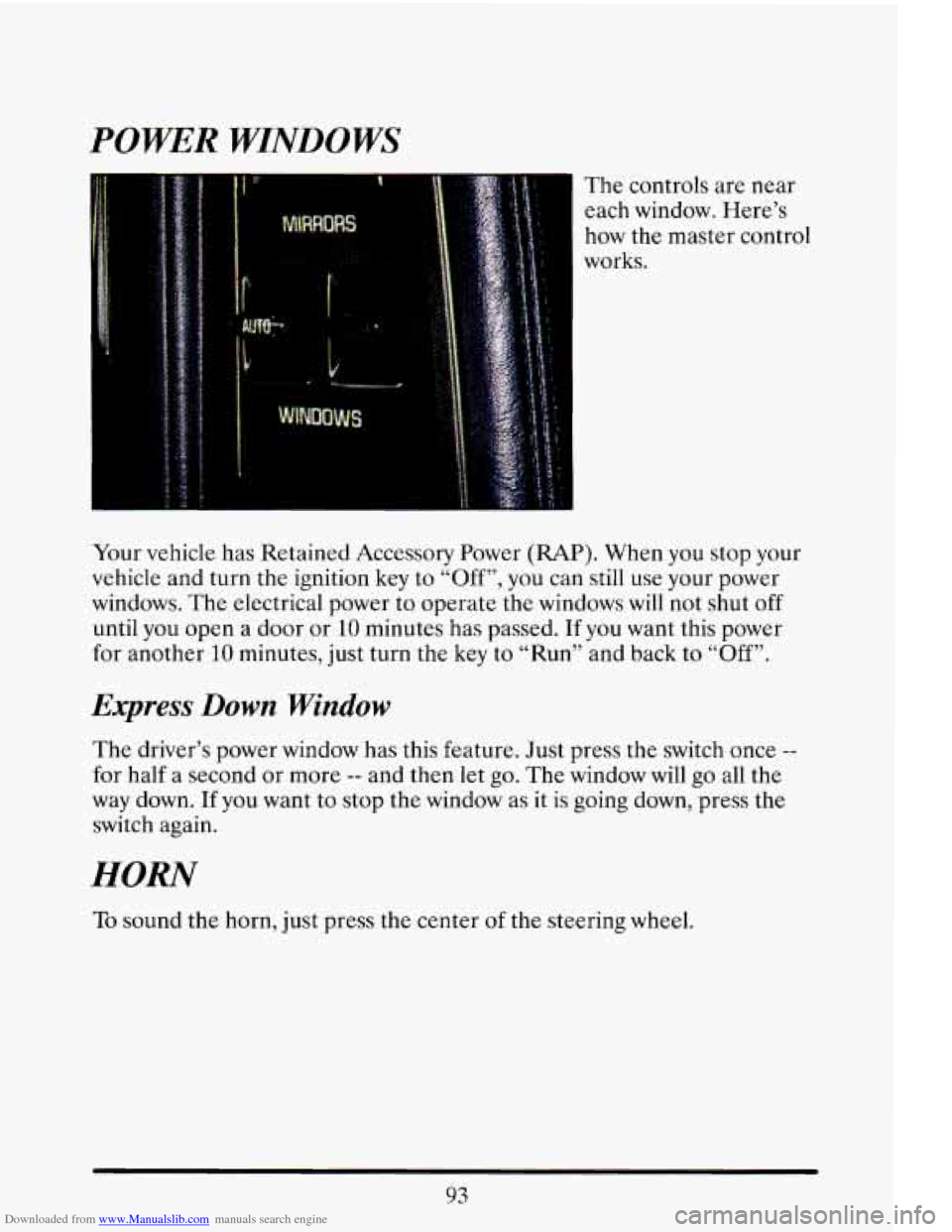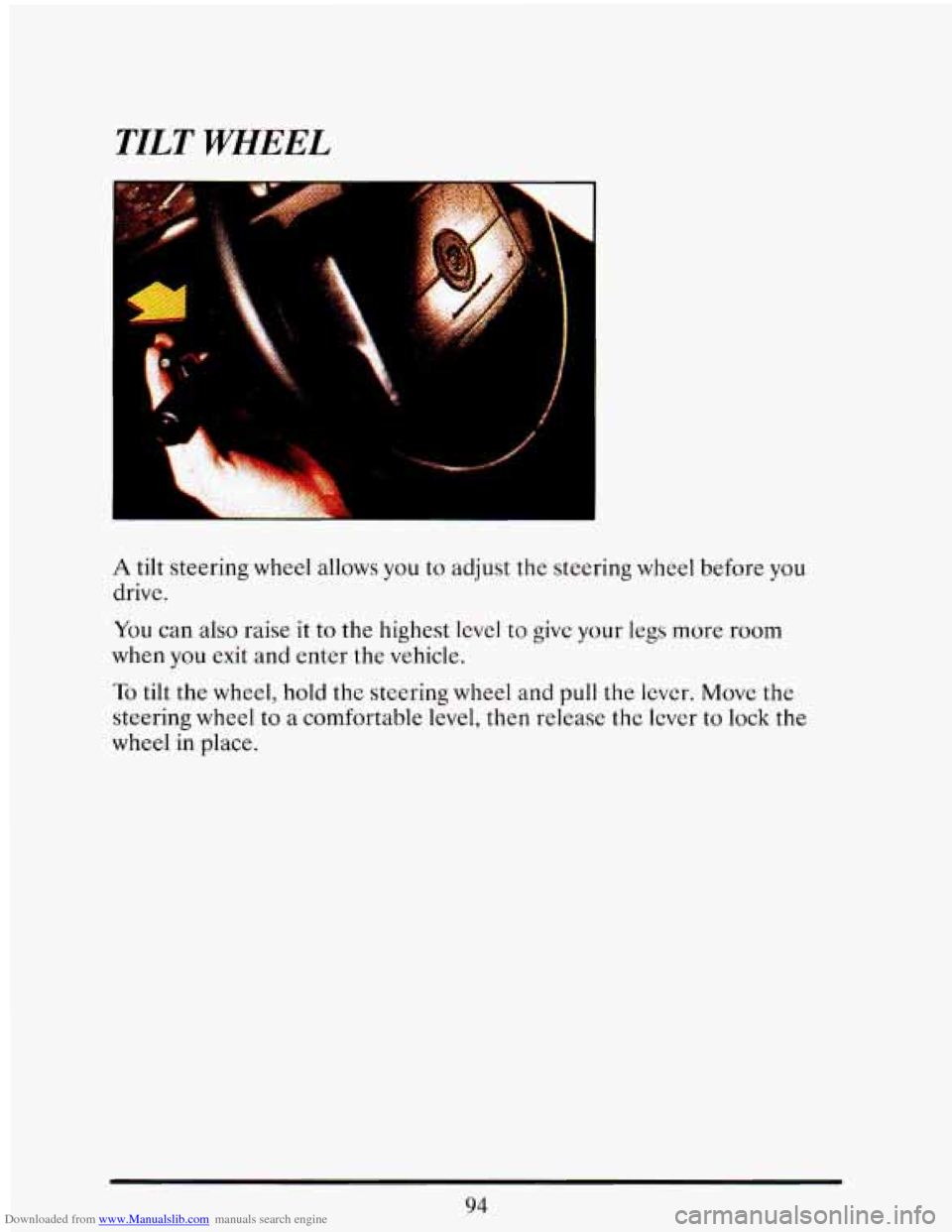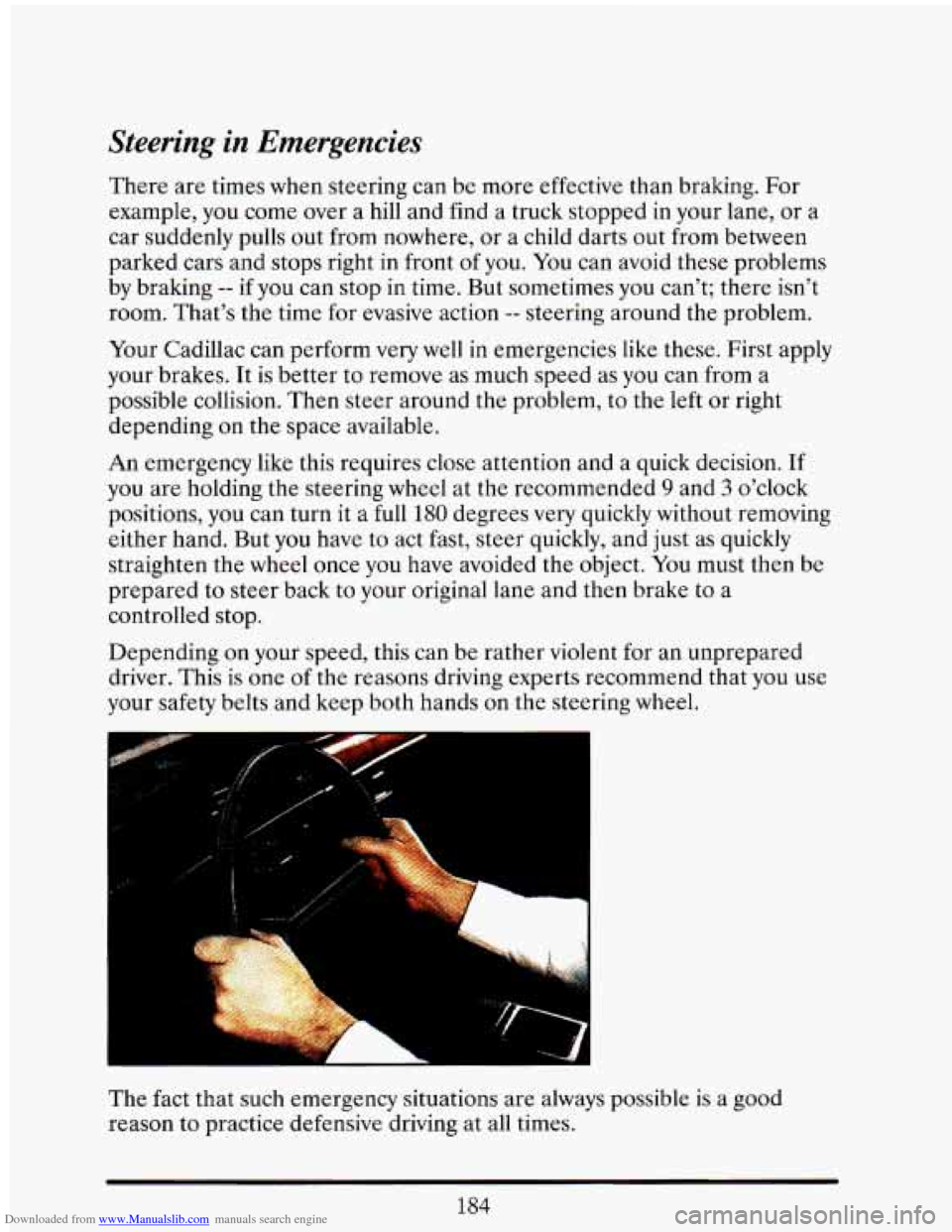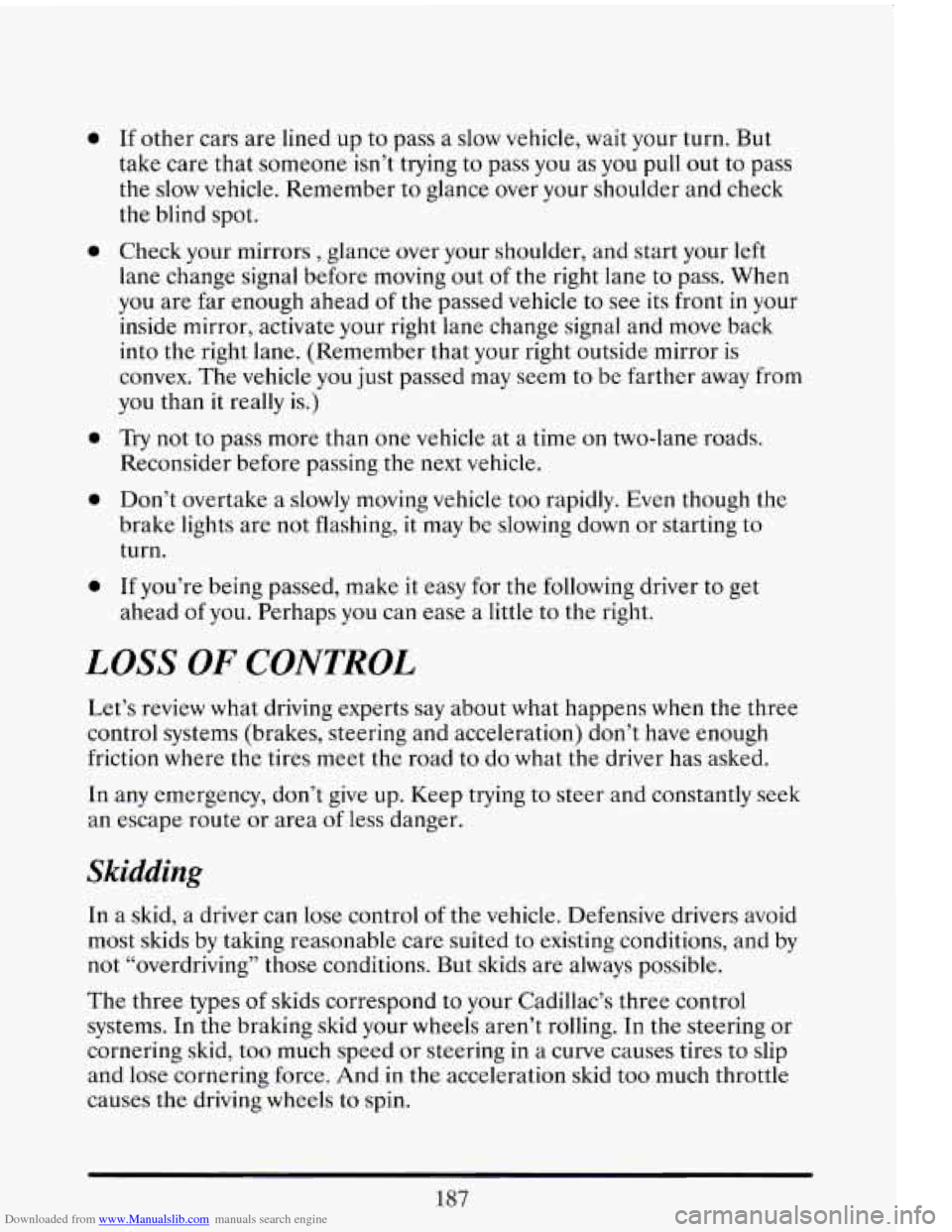1993 CADILLAC ELDORADO steering wheel
[x] Cancel search: steering wheelPage 100 of 398

Downloaded from www.Manualslib.com manuals search engine If you are on a hill: See “Parking on Hills” in thc Index. That section
shows how to turn your front wheels.
If vou are towing a trailer and are parking; on anv hill: See “Towing a
Trailer” in the Index. That section shows what to do first to keep the
trailer from moving.
SHIFTING INTO ‘CPn (PARK)
I
A CAUTION:
It can be dangerous to get out of your vehicle if the shift lever is
not fully.in “P” (Park) with the parking brake firmly set. Your
vehicle can roll.
If you have left the engine running, the vehicle can move
suddenly.
You or others could be injured. To be sure your vehicle
won’t move, when you’re on fairly level ground, use the
steps
that follow. If you are parking on a hill, or if you’re pulling a
trailer, also see “Parking On Hills” or “Towing a Wailer” in the
Index.
-.
Steering Column Shifl Lever
1. Hold the brake pedal down with your right foot.
86
Page 107 of 398

Downloaded from www.Manualslib.com manuals search engine POWER WINDOWS
The controls are near each window. Here’s
how the master control
I works.
Your vehicle has Retained Accessory Power
(RAP). When you stop your
vehicle and turn the ignition key to “Off”, you can still use your power
windows. The electrical power to operate the windows will not shut
off
until you open a door or 10 minutes has passed. If you want this power
for another
10 minutes, just turn the key to “Run” and back to “Off”.
Express Down Window
The driver’s power window has this feature. Just press the switch once --
for half a second or more -- and then let go. The window will go all the
way down. If you want to stop the window as it is going down, press the
switch again.
HORN
To sound the horn, just press the center of the steering wheel.
93
Page 108 of 398

Downloaded from www.Manualslib.com manuals search engine TILT WHEEL
1
A tilt steering wheel allows you to adjust the steering wheel before you
drive.
You can also raise it to the highest level to give your legs more room
when you exit and enter the vehicle.
To tilt the wheel, hold the steering wheel and pull the levcr. Move the
steering wheel to a comfortable level, then release the lcver to lock the
wheel
in place.
94
Page 153 of 398

Downloaded from www.Manualslib.com manuals search engine TURN SIGNAL ON
This message is a reminder, after driving about a mile that you have your
turn
signal on.
TRUNK OPEN
This message indicates that your trunk is opcn when the Ignition is ON.
VERY LOW REFRIGERANT
This message means that the Air Conditioning system detects a
refrigerant level that is low enough to cause damage to the A/C
compressor.
To avoid damage, the A/C compressor automatically turns
off and the Electronic Climate Control will automatically switch from
“AUTO” to “ECON” and remain there. Have your
A/C system serviced if
this message appears.
Speed Sensitive Steering (SSS)
This system varies the amount of steering effort proportionate to your
vehicle speed. Steering is easier at
a lower speed for increased
maneuverability and parking ease.
As your vehicle speed increases, the
steering effort
is also increased proportionately. At highway speeds the
amount
of steering effort is greatly increased to provide a manual like
steering feel for maximum control
an enhanced vehicle stability.
Road Sensing Suspension (Northstar Only)
The Road Sensing Suspension automatically controls the ride of your
vehicle.
The system controls damping forces in the shock absorbers and
struts in response to various road and driving conditions. The system is
capable
of making these changes within milli-seconds.
The
Road Sensing Suspension controller is a computer used to control
and monitor the system. The computer receives inputs from vertical
acceleration sensors, wheel
to body position sensors, vehicle speed
sensor, lift and dive signals, and determines optimum strut valving or
(suspension stiffness) for your current operating conditions.
The
computer also receives feedback from the various components to
determine proper system operation. If the computer receives an incorrect
feedback from the system, an error code will be
set in memory and a
“SERVICE RIDE CONTROC’ message will display on the Driver
139
Page 197 of 398

Downloaded from www.Manualslib.com manuals search engine Steering Tips
Driving on Curves
It’s important to take curves at a reasonable speed.
A lot of the “driver lost control” accidents mentioned on the news
happen on curves. Here’s why:
Experienced driver or beginner, each of
us is subject to the same laws of
physics when driving on curves. The traction
of the tires against the road
surface makes it possible for the vehicle to change its path
when you turn
the front wheels. If there’s
no traction, inertia will keep the vehicle going
in the same direction.
If you’ve ever tried to steer a vehicle on wet ice,
you’ll understand this.
The traction you can get in a curve depends on the condition
of your tires
and the road surface,
the angle at which the curve is banked, and your
speed. While you’re in a curve, speed is the one factor you can control.
Suppose you’re steering through
a sharp curve. Then you suddenly
accelerate.
Those two control systems -- steering and acceleration -- can overwhelm
those places where the tires meet the road and make you lose control.
What should you do if this ever happens? Let up on the accelerator
pedal, steer the vehicle the way
you want it to go, and slow down.
Speed limit signs near curves warn that you should adjust your speed.
Of
course, the posted speeds are based on good weather and road
conditions. Under less favorable conditions you’ll want to go slower.
If you need to reduce your speed as you approach
a curve, do it before
you enter the curve, while your front wheels are straight ahead.
Try to adjust your speed so you can “drive” through the curve. Maintain a
reasonable, steady speed. Wait to accelerate until you are out
of the
curve, and then accelerate gently into the straightaway.
When you drive into a curve at night, it’s harder to see the road ahead of
you because it bends away from the straight beams of your lights. This is
one good reason
to drive slower.
183
Page 198 of 398

Downloaded from www.Manualslib.com manuals search engine Steering in Emergencies
There are times when steering can be more effective than braking. For
example, you come over a
hill and find a truck stopped in your lane, or a
car suddenly pulls out from nowhere, or a child darts out from between
parked cars and stops right in front of you. You can avoid these problems
by braking
-- if you can stop in time. But sometimes you can’t; there isn’t
room. That’s the time for evasive action
-- steering around the problem.
Your Cadillac can perform very well in emergencies like these. First apply
your brakes. It is better
to remove as much speed as you can from a
possible collision. Then steer around the problem,
to the left or right
depending on the space available.
An emergency like this requires close attention and a quick decision. If
you are holding the steering wheel at the recommended
9 and 3 o’clock
positions, you can turn it a
full 180 degrees very quickly without removing
either hand. But you have to act fast, steer quickly, and just as quickly
straighten the wheel once you have avoided the object. You must then be
prepared to steer back to your original lane and then brake to a
controlled stop.
Depending on your speed, this can be rather violent for an unprepared
driver. This
is one of the reasons driving experts recommend that you use
your
safety belts and keep both hands on the steering wheel.
The fact that such emergency situations are always possible
is a good
reason to practice defensive driving at all times.
184
Page 199 of 398

Downloaded from www.Manualslib.com manuals search engine OFF-ROAD RECOWRY
You may find sometime that your right wheels have dropped off the edge
of a road onto the shoulder while you’re driving.
If the level of the shoulder is only slightly below the pavement, recovery
should be fairly easy. Ease off the accelerator and then, if there is nothing
in the way, steer
so that your vehicle straddles the edge of the pavement.
You can turn the steering wheel up to
1/4 turn until the right front tire
contacts the pavement edge. Then turn your steering wheel to go straight
down the roadway.
If the shoulder appears to be about four inches
(100 mm) or more below
the pavement, this difference can cause problems. If there is not enough
room to pull entirely onto the shoulder and stop, then follow the same
procedures. But if the right front tire scrubs against the side
of the
pavement, do
NOT steer more sharply. With too much steering angle, the
vehicle may jump back onto the road with
so much steering input that it
crosses over into the oncoming traffic before you can bring it back under
control.
Instead, ease
off again on the accelerator and steering input, straddle the
pavement once more, then try again.
185
Page 201 of 398

Downloaded from www.Manualslib.com manuals search engine 0
a
0
a
0
If other cars are lined up to pass a slow vehicle, wait your turn. But
take care that someone isn’t trying to pass you as you pull out to pass
the slow vehicle. Remember to glance over your shoulder and check
the blind spot.
Check your mirrors
, glance over your shoulder, and start your left
lane change signal before moving out
of the right lane to pass. When
you are far enough ahead
of the passed vehicle to see its front in your
inside mirror, activate your right lane change signal and move back
into the right lane. (Remember that your right outside mirror is
convex. The vehicle
you just passed may seem to be farther away from
you than it really is.)
Try not to pass more than one vehicle at a time on two-lane roads.
Reconsider before passing the
next vehicle.
Don’t overtake
a slowly moving vehicle too rapidly. Even though the
brake lights are not flashing, it may be slowing down or starting to
turn.
If you’re being passed, make it easy for the following driver to get
ahead of you. Perhaps you can ease a little to the right.
LOSS OF CONTROL
Let’s review what driving experts say about what happens when the three
control systems (brakes, steering and acceleration) don’t have enough
friction where the tires meet the road to do what
the driver has asked.
In any emergency, don’t give up. Keep trying to steer and constantly seek
an escape route or area
of less danger.
Skidding
In a skid, a driver can lose control of the vehicle. Defensive drivers avoid
most skids by taking reasonable care suited to existing conditions, and
by
not “overdriving” those conditions. But skids are always possible.
The three types
of skids correspond to your Cadillac’s three control
systems. In the braking skid your wheels aren’t rolling. In the steering or
cornering skid, too much speed
or steering in a curve causes tires to slip
and
lose cornering force. And in the acceleration skid too much throttle
causes the driving wheels to spin.